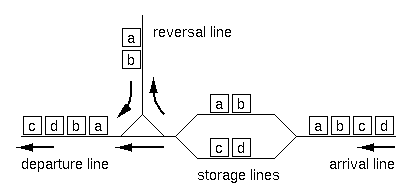POJ3007(Organize Your Train part II)
| Time Limit: 1000MS | Memory Limit: 65536K | |
Description
RJ Freight, a Japanese railroad company for freight operations has recently constructed exchange lines at Hazawa, Yokohama. The layout of the lines is shown in Figure 1.

Figure 1: Layout of the exchange lines
A freight train consists of 2 to 72 freight cars. There are 26 types of freight cars, which are denoted by 26 lowercase letters from "a" to "z". The cars of the same type are indistinguishable from each other, and each car's direction doesn't matter either. Thus, a string of lowercase letters of length 2 to 72 is sufficient to completely express the configuration of a train.
Upon arrival at the exchange lines, a train is divided into two sub-trains at an arbitrary position (prior to entering the storage lines). Each of the sub-trains may have its direction reversed (using the reversal line). Finally, the two sub-trains are connected in either order to form the final configuration. Note that the reversal operation is optional for each of the sub-trains.
For example, if the arrival configuration is "abcd", the train is split into two sub-trains of either 3:1, 2:2 or 1:3 cars. For each of the splitting, possible final configurations are as follows ("+" indicates final concatenation position):
[3:1]
abc+d cba+d d+abc d+cba
[2:2]
ab+cd ab+dc ba+cd ba+dc cd+ab cd+ba dc+ab dc+ba
[1:3]
a+bcd a+dcb bcd+a dcb+a
Excluding duplicates, 12 distinct configurations are possible.
Given an arrival configuration, answer the number of distinct configurations which can be constructed using the exchange lines described above.
Input
The entire input looks like the following.
the number of datasets = m
1st dataset
2nd dataset
...
m-th dataset
Each dataset represents an arriving train, and is a string of 2 to 72 lowercase letters in an input line.
Output
For each dataset, output the number of possible train configurations in a line. No other characters should appear in the output.
Sample Input
4 aa abba abcd abcde
Sample Output
1 6 12 18
Source
1 #include<set> 2 #include<map> 3 #include<queue> 4 #include<cstdio> 5 #include<cstdlib> 6 #include<cstring> 7 #include<algorithm> 8 using namespace std; 9 const int N=30; 10 const int MAXN=80; 11 #define For(i,n) for(int i=1;i<=n;i++) 12 #define Rep(i,l,r) for(int i=l;i<=r;i++) 13 #define Down(i,r,l) for(int i=r;i>=l;i--) 14 15 struct trie{ 16 int sz,ch[N*MAXN*10][N],v[N*MAXN*10]; 17 void clr(){sz=1;memset(v,0,sizeof(v));memset(ch,0,sizeof(ch));} 18 int insert(char st[]){ 19 int now=v[1]=1,len=strlen(st); 20 Rep(i,0,len-1){ 21 int id=st[i]-'a'; 22 if(!ch[now][id]) ch[now][id]=++sz; 23 v[now=ch[now][id]]++; 24 } 25 if(v[now]>=2) return 0; 26 else return 1; 27 } 28 }trie; 29 30 char word[MAXN],prefix[MAXN],suffix[MAXN],New[MAXN]; 31 int n,T,ans; 32 33 void Reverse(char *s){ 34 int len=strlen(s); 35 Rep(i,0,(len-1)/2){ 36 char t=s[i];s[i]=s[len-i-1];s[len-i-1]=t; 37 } 38 } 39 40 void solve(){ 41 n=strlen(word); 42 Down(i,n-1,1){ 43 strncpy(prefix,word,i);prefix[i]='\0'; 44 Rep(l,0,1){ 45 if(l==1&&(i==1)) continue; 46 if(l) Reverse(prefix); 47 Rep(k,i,n-1) suffix[k-i]=word[k];suffix[n-i]='\0'; 48 Rep(j,0,1){ 49 if(j==1&&(i==n-1)) continue; 50 if(j) Reverse(suffix); 51 strcpy(New,prefix);strcat(New,suffix); 52 ans+=trie.insert(New); 53 strcpy(New,suffix);strcat(New,prefix); 54 ans+=trie.insert(New); 55 } 56 } 57 } 58 printf("%d\n",ans);ans=0; 59 } 60 61 int main(){ 62 scanf("%d",&T); 63 For(i,T){ 64 trie.clr(); 65 scanf("%s",&word); 66 solve(); 67 } 68 return 0; 69 }






【推荐】凌霞软件回馈社区,博客园 & 1Panel & Halo 联合会员上线
【推荐】轻量又高性能的 SSH 工具 IShell:AI 加持,快人一步
· 智能桌面机器人:用.NET IoT库控制舵机并多方法播放表情
· Linux glibc自带哈希表的用例及性能测试
· 深入理解 Mybatis 分库分表执行原理
· 如何打造一个高并发系统?
· .NET Core GC压缩(compact_phase)底层原理浅谈
· 开发者新选择:用DeepSeek实现Cursor级智能编程的免费方案
· Tinyfox 发生重大改版
· 独立开发经验谈:如何通过 Docker 让潜在客户快速体验你的系统
· 小米CR6606,CR6608,CR6609 启用SSH和刷入OpenWRT 23.05.5
· 近期最值得关注的AI技术报告与Agent综述!